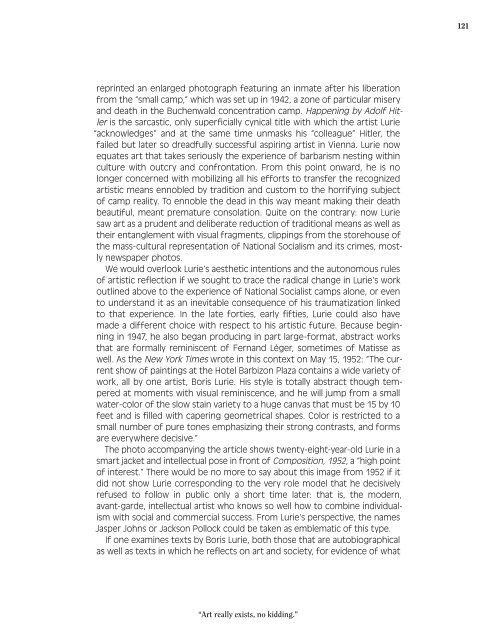The Art of
Katalog_Boris-Lurie_English
Katalog_Boris-Lurie_English
Create successful ePaper yourself
Turn your PDF publications into a flip-book with our unique Google optimized e-Paper software.
121<br />
reprinted an enlarged photograph featuring an inmate after his liberation<br />
from the “small camp,” which was set up in 1942, a zone <strong>of</strong> particular misery<br />
and death in the Buchenwald concentration camp. Happening by Adolf Hitler<br />
is the sarcastic, only superficially cynical title with which the artist Lurie<br />
“acknowledges” and at the same time unmasks his “colleague” Hitler, the<br />
failed but later so dreadfully successful aspiring artist in Vienna. Lurie now<br />
equates art that takes seriously the experience <strong>of</strong> barbarism nesting within<br />
culture with outcry and confrontation. From this point onward, he is no<br />
longer concerned with mobilizing all his efforts to transfer the recognized<br />
artistic means ennobled by tradition and custom to the horrifying subject<br />
<strong>of</strong> camp reality. To ennoble the dead in this way meant making their death<br />
beautiful, meant premature consolation. Quite on the contrary: now Lurie<br />
saw art as a prudent and deliberate reduction <strong>of</strong> traditional means as well as<br />
their entanglement with visual fragments, clippings from the storehouse <strong>of</strong><br />
the mass-cultural representation <strong>of</strong> National Socialism and its crimes, mostly<br />
newspaper photos.<br />
We would overlook Lurie’s aesthetic intentions and the autonomous rules<br />
<strong>of</strong> artistic reflection if we sought to trace the radical change in Lurie’s work<br />
outlined above to the experience <strong>of</strong> National Socialist camps alone, or even<br />
to understand it as an inevitable consequence <strong>of</strong> his traumatization linked<br />
to that experience. In the late forties, early fifties, Lurie could also have<br />
made a different choice with respect to his artistic future. Because beginning<br />
in 1947, he also began producing in part large-format, abstract works<br />
that are formally reminiscent <strong>of</strong> Fernand Léger, sometimes <strong>of</strong> Matisse as<br />
well. As the New York Times wrote in this context on May 15, 1952: “<strong>The</strong> current<br />
show <strong>of</strong> paintings at the Hotel Barbizon Plaza contains a wide variety <strong>of</strong><br />
work, all by one artist, Boris Lurie. His style is totally abstract though tempered<br />
at moments with visual reminiscence, and he will jump from a small<br />
water-color <strong>of</strong> the slow stain variety to a huge canvas that must be 15 by 10<br />
feet and is filled with capering geometrical shapes. Color is restricted to a<br />
small number <strong>of</strong> pure tones emphasizing their strong contrasts, and forms<br />
are everywhere decisive.”<br />
<strong>The</strong> photo accompanying the article shows twenty-eight-year-old Lurie in a<br />
smart jacket and intellectual pose in front <strong>of</strong> Composition, 1952, a “high point<br />
<strong>of</strong> interest.” <strong>The</strong>re would be no more to say about this image from 1952 if it<br />
did not show Lurie corresponding to the very role model that he decisively<br />
refused to follow in public only a short time later: that is, the modern,<br />
avant-garde, intellectual artist who knows so well how to combine individualism<br />
with social and commercial success. From Lurie’s perspective, the names<br />
Jasper Johns or Jackson Pollock could be taken as emblematic <strong>of</strong> this type.<br />
If one examines texts by Boris Lurie, both those that are autobiographical<br />
as well as texts in which he reflects on art and society, for evidence <strong>of</strong> what<br />
“<strong>Art</strong> really exists, no kidding.”



